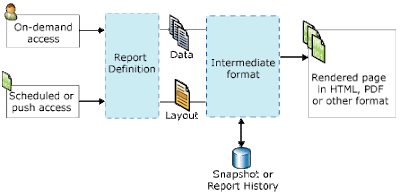Drilldown
reports
Drilldown reports must
retrieve all possible data that can be shown in the report. For reports that
use large amounts of data, consider drillthrough reports instead.
Subreports
A subreport is a report
item that you add to a report as a layout element. A subreport points to a
different report and displays inside the body of a main report as an subreport
instance.
Main/detail
reports and drillthrough reports
A main/detail report
solution includes a main report that displays summary information with
hyperlinks to one or more reports that display detailed information.
Linked reports
A linked report is a
report server item that contains a pointer to the report definition but has its
own set of report properties and settings. These include security, parameters,
location, subscriptions, and schedules.
History
reports
Report history is a
collection of report snapshots. You can use report history to maintain a record
of a report over time.
Cached reports
A cached report is a
saved copy of a compiled report and report data. Cached reports are used to
improve performance by reducing the number of processing requests to the report
processor and by reducing the time that is required to retrieve large report
datasets.
Snapshots
A report snapshot is a
report that contains layout information and query results that were retrieved
at a specific point in time.
Model reports
and Clickthrough reports
(i) Report model :A report model is a
user-friendly description of an underlying database, with pre-established data
relationships and auto-generated queries. Report models can be used as data
sources for reports created in Report Designer and Report Builder.
(ii)Clickthrough
report : A clickthrough report is a report that displays related data
from a report model when you click the interactive data contained in the
model-based report. Clickthrough reports are autogenerated.
Saved reports
A saved report is a
report definition (.rdl) file. A report definition can be saved locally or
uploaded to a report server.
Published reports
A published report is a
report server item that you publish to a report server from a Reporting
Services tool.
Upgraded
reports
An upgraded report is a
published report definition that is converted to a newer schema when a report
server is upgraded from one version of Reporting Services to a later version.
The original report definition is preserved. The report is upgraded in memory,
compiled, and the compiled version is saved internally.

